LUBRICATION
ENGINE LUBRICATION SYSTEM (Fig. 2-1)
Oil is delivered by the oil pump to the oil filter, (standard equipment on all models) then to the rear main bearing, and to the main oil galley on the right side. This main galley supplies the valve lifters on the right side, the front four main bearings, the timing chain and sprocket, the fuel pump lever and eccentric, and the left side oil galley. The left galley supplies the valve lifters on the left side and the distributor drive gear. The main bearings supply their respective camshaft bearings. No. 2 and No. 4 camshaft bearings meter oil to the rocker arm shafts and through these to the rocker arms and push rods. Connecting rod bearings are supplied by the main bearings through drilled passages in the crankshaft. Cylinder wall lubrication is accomplished by means of a spit hole in each connecting rod.
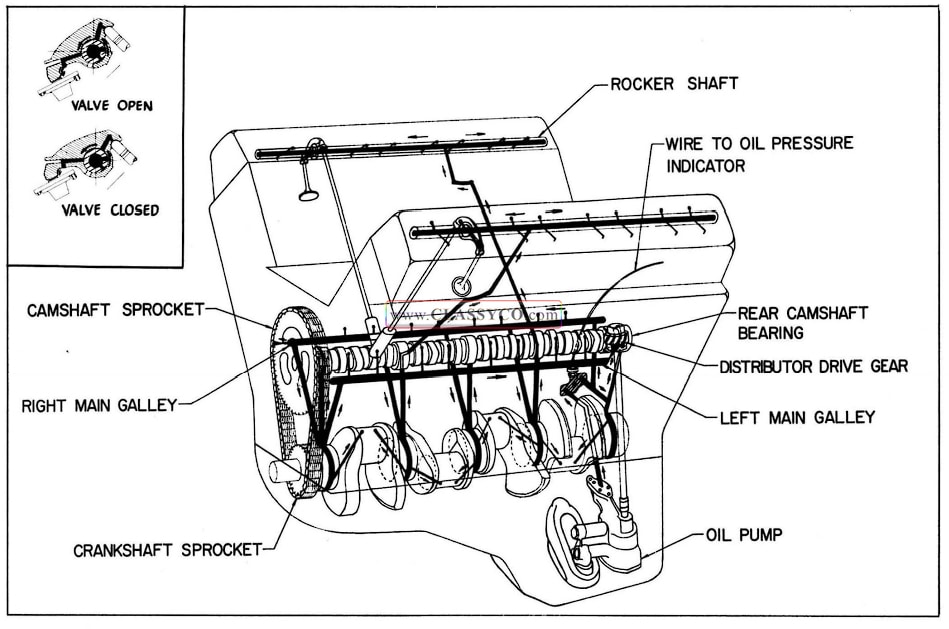
1957 Oldsmobile Engine Lubrication System
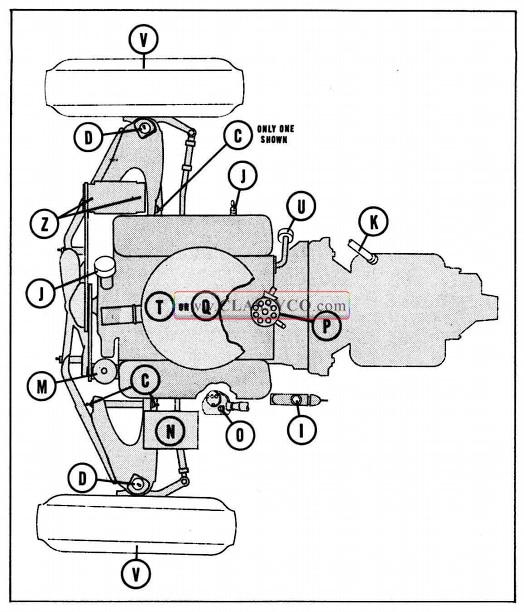
1957 Oldsmobile Instruction 1
EVERY 2,000 MILES
CHASSIS LUBRICANT
A. Lower control arm pivot shafts ……4 points
B. Lower control arm ball joints ………2 points
C. Upper control arm pivot shafts ……4 points
D.Upper control arm ball joints ………2 points
E. Inner and outer tie rod ends ……….4 points
F. Steering idler arm bushing…………. 1 point
G. Brake and clutch pedal bushings….1 or 2 points
CHECK FLUID LEVEL-REPLENISH
H. Differential ………………………………SAE 90 Multi-Purpose Gear Lubricant
I. Master Brake Cylinder …………….. .G.M. Brake Fluid No. 11
J. Engine Oil ………………………………..MS or DG Oil of Proper Viscosity
K. Hydra-Matic ……………………………G.M. Hydra-Matic Fluid
L. Syncro-Mesh Transmission ……….SAE 80 Multi-Purpose Gear Lubricant
M. Steering Gear (Power) ……………..G.M. Hydra-Matic Fluid
N. Battery ……………………………………Distilled Water
O. Steering Gear (Standard) ………….SAE 80 Multi-Purpose Gear Lubricant
ENGINE OIL ON FOLLOWING POINTS
P. Distributor ………………………………Fill lubrication tube with Engine Oil
Z. Generator Oil Cups-front and rear**
Throttle and Transmission Linkage Pivot Points **
Parking Brake Linkage**
Q. Standard Air Cleaner* -Clean filter and re-oil with engine oil (SAE 40)
J. Crankcase Inlet Breather Cap* -Wash in solvent and re-oil with engine oil at time of engine oil change
BODY LUBRICATION
Door Lock Striker Teeth-Light coat of stick type lubricant. Rotary Lock Pivot-Drop or two of SAE 20 oil.
Rotary Lock Housing Upper Surface-Light coat of stick type lubricant.
Door Hold Open-Thin film of “Lubriplate” on friction surfaces.
Door Hinges-Drop of oil on pivot points.
Hood Hinges-Apply SAE 20 oil at pivot points.
Hood Latch-Thin flim of “Lubriplate” on friction surfaces. Rear Deck Lid Lock Bolt-Apply “Lubriplate” to bolt at striker contact area.
Door and Rear Deck Lock Cylinders-Lubricate with lock lubricant whenever hard to insert key.
Gas Tank Filler Door Hinge-Lubricate with SAE 20 oil.
Door Weatherstrip-Dow Corning No. 4 Silicone Grease.
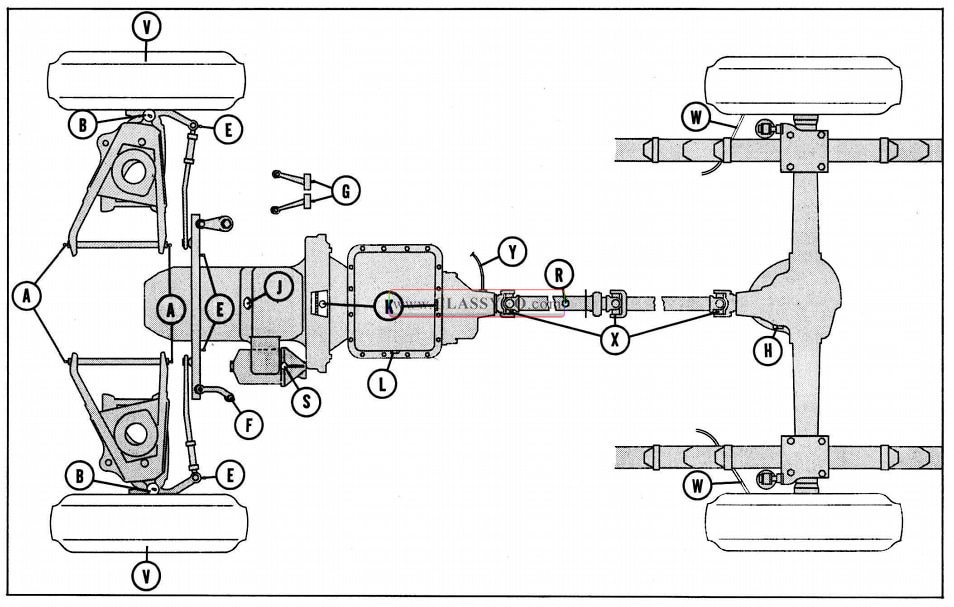
1957 Oldsmobile Instruction 2
EVERY 4,000 MILES
N. Battery-Clean top of battery and cable terminals; Apply a thin film of petrolatum to battery posts and clamps; Install new felt washers on battery posts.
EVERY 6,000 MILES
R. Slip Yoke-Install fitting in place of plug, lubricate with Special lubricant 571 035 until lubricant appears at slip yoke nut at rear of front propeller shaft, then reinstall plug.
P. Distributor-Apply a film of Delco-Remy Cam and Bearing lubricant to the breaker cam.
S. Oil Filter-Replace cartridge at oil change nearest 5,000 mile interval.
T. Heavy Duty (oil bath) Air Cleaner* -Clean and replenish with SAE 40 oil (1 pint).
U. Crankcase Ventilating Tube Breather*-Wash in solvent whenever heavy duty cleaner is serviced.
EVERY 8,000 MILES
V. Front Wheel Bearings-Clean and pack with high melting point wheel bearing grease (fine fiber, sodium base).
EVERY 10,000 MILES
W. Parking Brake Cables-lubricate with brake cable lubricant.
EVERY 20,000 MILES
X. Universal Joints-Disassemble, clean, and repack with high melting point wheel bearing grease (fine fibE1r, sodium base).
EVERY 25,000 MILES
K. Hydra-Matic-Drain and refill with G.M. Hydra-Matic Fluid.
Y. Speedometer Cable-lubricate lower 2h with AG Speedometer Grease.
*Severe weather or driving conditions necessitate more frequent attention.
** Unless otherwise specified use SAE 20 when engine oil is required.
CRANKCASE VENTILATION (Fig. 2-2)
The crankcase ventilating system aids in pre venting harmful dilution of the engine oil. The fan blast causes air to enter the crankcase through the filter element in the oil filler tube breather cap. The vapors are exhausted throught the ventilator tube which connects to the rear of the engine. The ventilator tube projects down into the air stream beneath the car at a low pressure area which aids in drawing vapors from the crankcase.
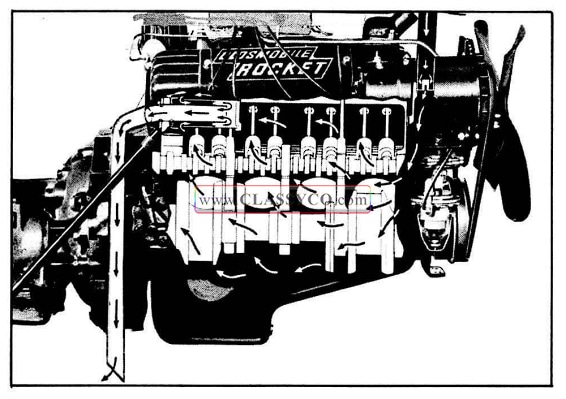
1957 Oldsmobile Crankcase Ventilation
ENGINE CRANKCASE OIL
The TYPE of engine oil used will affect operation, wear, and combustion chamber deposits; the oil VISCOSITY will affect oil economy and easy starting. It is, therefore, important that the recommendations made in this section regarding TYPE, VISCOSITY, and OIL CHANGE INTERVAL be followed.
Type of Oil
There are four harmful deposits which can form in the crankcase of an engine, namely; sludge, varnish, moisture, and corrosive acids. The formation of these deposits depends on the quality of oil and the additives therein, engine operating temperature and the type of driving. They form under both low and high speed driving conditions, but generally form more rapidly in cold weather under short-run or city driving conditions. Thus, either continued high speed driving or considerable periods of stop and go driving constitutes “severe” driving conditions insofar as motor oil is concerned. Because the Rocket engine is manufactured to very close tolerances for long life and dependability, these deposits, if allowed to form, will cause operating problems.
Formation of these deposits can be substantially reduced by using oils that contain the correct type and quantity of additives. Sludge is reduced by additives having detergent dispersant characteristics. Varnish deposits are reduced by oxidation inhibitors. Bearing corrosion is eliminated by corrosion preventive additives. Only certain types of oil have sufficient of these additives. There fore, only these types can be recommended for satisfactory service in the Rocket engine.
The following information describes the various types of oil now being marketed and the reasons they should or should not be used in the Rocket engine.
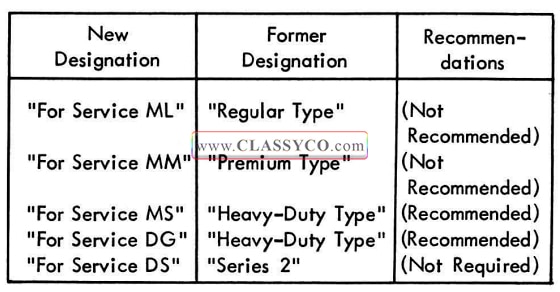
1957 Oldsmobile Various types of Oil and Reasons they should or should not be used
ML (Comparable to former Regular Type) Not recommended
This oil is designed for light service in engines not critically affected by sludge and varnish deposits.
MM (Comparable to former Premium Type) Not recommended.
This oil has additives to reduce sludge, varnish, and acids, but not in sufficient quantities to be recommended for use in Rocket engines.
MS and DG (Comparable to former Heavy-Duty Type) – Recommended.
These oils are recommended for use in Rocket engines as they have sufficient additives to minimize formation of sludge, varnish, and acids under normal driving conditions.
DS (Comparable to former Series-2 Type)
This oil is specially compounded for use in diesel engines under severe operating conditions, and is not generally available at filling stations. It can be used satisfactorily in Rocket engines, but is not required. It contains a larger quantity of additives than the MS or DG oils.
Brands of Oil
In selecting a brand of engine oil, it is advisable to consider the reputation of the refiner and distributor, as they are responsible for the quality of the product and their reputation is the car owner’s best indication of quality. To obtain maximum performance and satisfaction from the Rocket engine, it is important to use only crank case oils that have been proven, in service, to be satisfactory in minimizing wear as well as sludge, varnish, and acidic deposits.
Even though designated “For Service MS” or “For Service DG”, some commercial crankcase oils form the type of combustion chamber deposits that increase the tendency for detonation and pre ignition; also, some are deficient in anti-wear characteristics and may contribute to rapid wear of engine parts, such as camshaft, valve lifters, rocker arms, and piston rings.
Under adverse operating conditions where a greater concentration of additives is required, a High Detergency Concentrate which has been thoroughly tested and recommended is available under General Motors Part No. 564800.
The use of proprietary compounds, such as, “break-in” oils, “tune-up” compounds, “tonics” “friction reducing” compounds, etc., are entirely unnecessary and are not recommended for use in the Rocket engine.
Oil Viscosity
SAE viscosity numbers specify viscosity only and should not be confused with “Type of Oil”. The lower viscosity or “thinner” oils, such as, SAE 5W, or SAE 10W are designed for use during cold weather to provide fast starting and instant lubrication. The higher viscosity or “thicker” oils, such as, SAE 20 or SAE 20W are designed for use during warm or hot weather to provide adequate lubrication and satisfactory oil consumption under higher operating temperatures.
Several oil companies now market multiple viscosity oils, such as, SAE 5W -20, SAE 10W -20, SAE 10W -30, etc., which are designed to combine the fast starting and instant lubrication characteristics of the lower SAE number with the warm weather operating characteristics of the higher SAE number.
The proper oil viscosity to use depends upon the range in atmospheric temperatures that will be encountered during the period the oil remains in the crankcase. More-than-normal oil consumption will be encountered during warm or hot weather, particularly under high speed driving conditions, if the oil viscosity is too low. The following chart will serve as a guide to the proper oil viscosity to use under various atmospheric temperature conditions. It is not necessary to change oil for the unseasonably cold or warm days encountered during the fall or spring season.
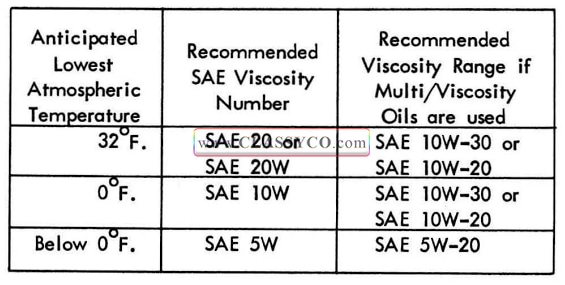
1957 Oldsmobile Oil Viscosity Table
NOTE: The SAE viscosity number should be plainly marked on the oil containers.
SAE 5W oils are not recommended for sustained high speed driving during warm weather.
For sustained high speed driving when the prevailing daylight temperature is above 90°F, SAE 30 may be used.
SAE 5W and SAE 5W -20 oils are particularly advantageous during low temperatures because the easy starting and quick flow characteristics of these oils greatly reduce the drain on the battery in cold weather.
Oil Change Interval
The crankcase of the Rocket engine was filled at the factory with MS or DG oil. If it is necessary to add oil before the first drain period, use oil of type and viscosity recommended in the preceding paragraphs on “Type of Oil” and “Viscosity”. Break-in oils are entirely unnecessary and their use is not recommended.
When changing oil, drain the crankcase after the engine has reached normal operating temperature to insure complete removal of the old oil. Oil pan drain plug torque is 35 to 40 ft. lbs.
The initial oil change and subsequent changes should be made in accordance with the following recommendations:
500 Mile Change Interval
This period should be used in cold weather when the car is used almost exclusively in the city for house-to-house or store-to-store operating conditions as experienced by doctors and city sales men.
1,000 Mile Change Interval
This interval should be used under average winter driving conditions when most of the driving is in the city with only occasional highway driving.
2,000 Mile Change Interval
This interval should be used under average summer driving conditions when the car is operated under inter-mixed city and highway driving, such as town driving during the week with a high way trip on week-ends.
3,000 Mile Change Interval
This interval should be used when the car is driven consistently on the highway with occasional city driving.
NOTE: If the car bas been driven in a dust or sand storm, the engine oil should be changed as soon as possible. When the car is operated on dirt roads or under dusty conditions, it may be necessary to change the oil more frequently than indicated in the above recommended intervals which were predicated on paved road driving conditions.
Crankcase Capacity
Oil change only, 5 qts.
Oil change and filter element change, 6 qts.
Oil Level (Fig. 2-3)
The oil gauge rod is marked “Full”, “Add 1,” and “Add 2”. The oil level should be maintained in the safety margin, (See Fig. 2-3), neither going above the “Full” line nor under the “Add 2” line. The oil level should be checked when refueling and oil added to maintain proper level. Do not over fill.
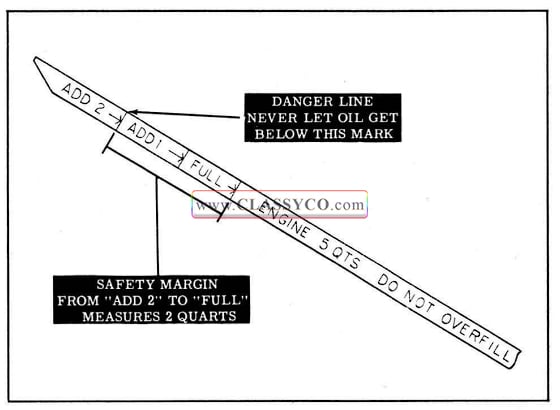
1957 Oldsmobile Oil Gauge Rod
OIL FILTER
A full flow oil filter, provided as standard equipment on all models, filters 100% of the oil de livered by the oil pump. For this reason the interval of change is very important. The oil filter cartridge should be replaced at oil change nearest the 5,000 mile change interval.
CHANGING OF OL FILTER CARTRIDGE
- Remove drain plug to drain cartridge container.
- Unscrew cartridge container center bolt to remove filter.
- Before installing new cartridge, clean out cartridge container, and place new seal in position in oil filter body casting.
NOTE: Oil filter drain plug should be torqued to 20 ft. lbs. and cartridge container center bolt to 40 ft. lbs.
AIR CLEANER
The standard air cleaner should be serviced every 2,000 miles when car is operated on paved roads and every 500 to 1,000 miles when car is operated on dirt roads or under dusty conditions.
The heavy duty oil bath cleaner should be serv iced every 6,000 miles when car is operated on paved roads and every 3,000 miles when car is operated on dirt roads under average dust conditions. Under extreme conditions in territories subject to dust storms or where industrial abrasives are prevalent, air cleaners require more frequent service.
The air cleaner should be serviced as follows:
- Remove filter element.
- Wash accumulated dirt from the filter element by plunging it up and down several times in clean solvent.
- On the standard cleaner, the filter element should be oiled with SAE 40 oil and replaced in the silencer unit. Do not wet felt in cover. If felt becomes wet, clean with clear solvent.
- On the heavy-duty cleaner, the element should be cleaned but not oiled. The reservoir should be cleaned and refilled to the indicated level with one pint of SAE 40 oil (SAE 20 oil for below 320F. temperatures).
CRANKCASE BREATHER
The crankcase inlet breather cap should be washed in solvent and re-oiled with SAE 20 oil at every oil change.
The crankcase ventilating tube breather element is used only on models factory equipped with heavy-duty oil bath air cleaner. The ventilating tube breather element should be cleaned in solvent and replaced, without oiling, whenever the heavy duty air cleaner is serviced.
THROTTLE AND TRANSMISSION LINKAGE
At every chassis lubrication interval remove road film from lubrication points, then apply engine oil to all friction and bearing surfaces on transmission control linkage and throttle linkage.
DISTRIBUTOR
The hinge cap oiler tube should be filled with SAE-20 engine oil at each chassis lubrication period. Every 6,000 miles and whenever the con tact set assembly is replaced, add a film of Delco Remy Cam and Ball Bearing Lubricant or equivalent to the breaker cam. No other lubrication is required. The movable breaker plate is lubricated by oil from the upper main shaft bushing.
STARTING MOTOR
No lubrication service is required except at overhaul. When starting motor is disassembled for servicing, 4 or 5 drops of engine oil should be added to bushings in the end frame and pinion housing.
GENERATOR
Hinge cap oilers are provided at both the com mutator and drive ends. At each vehicle lubrication period, the oilers should be filled to the cap with SAE 20 oil.
If the oil reserve in the commutator end bearing becomes completely exhausted through failure to lubricate at regular intervals, it will require more than a simple filling to restore the reserve. In such case, the oil cup should be filled three times consecutively, allowing time between fillings for the oil to soak down.
WATER PUMP
The water pump is permanently lubricated and needs no attention.
STANDARD STEERING GEAR
The necessity for frequent addition of lubricant indicates leakage and the source of leakage must be found and corrected. Use SAE 80 Multi-Purpose Gear Lubricant in standard steering gears. Regular or seasonal changes are unnecessary.
POWER STEERING GEAR AND PUMP
Check at every lubrication period, and maintain oil level at “Full” mark. Use Hydra-Matic Trans mission Fluid. Power steering gear lubrication is accomplished by the oil supplied to the gear by the power steering pump.
STEERING LINKAGE AND SUSPENSION
The front suspension and the steering linkage should be thoroughly lubricated with chassis lubricant at 2,000 mile intervals.
The rear suspension does not require lubrication. The rear springs are the uncovered type using wax impregnated liners. Rear springs should not be oiled.
RUBBER MOUNTINGS AND BUSHINGS
All load carrying rubber parts (bushings) are designed to function without slippage. After a very short period of service, they partially bond themselves to adjacent metal parts. This bonding action further reduces slippage.
Lubrication of rubber parts should be avoided, as lubrication defeats the purpose of the design and causes slippage. If a squeak should develop, a soapy water solution can be used. This solution will assist bonding of the rubber to the metal.
SHOCK ABSORBERS
Front and rear shock absorbers are of sealed type construction and do not require periodic checking of fluid level. If a shock absorber leaks or does not operate properly, it should be replaced.
HYDRA-MATIC TRANSMISSION
G.M. Hydra-Matic Fluid
This all-season fluid, designed for year-round operation is available through authorized dealers.
Fluid for the Hydra-Matic unit is also available through most independent oil companies. Only fluid with the following identification on the container should be used: brand name, including the words “… Fluid Type A”, plus an Armour qualification number embossed on top of can as follows: “AQ-ATF -number”.
Checking Hydra-Matic Fluid Level
Fluid level should be checked at every lubrication period. Check must be made with the engine idling and the selector lever in the park position. Fluid level must be maintained at the full mark. (Transmission warm)
CAUTION: Do not fill above full mark as this will cause foaming and will result in improper operation.
Draining Hydra-Matic Transmission
The Hydra-Matic fluid should be changed every 25,000 miles.
To drain the jetaway Hydra-Matic transmission oil, proceed as follows:
- Remove flywheel inspection plate.
- Remove 7 /16″ “hex head” pipe plug from torus cover and drain fluid from torus cover.
- Remove drain plug from transmission oil pan permitting fluid to drain.
- Install pipe plug in torus cover using Permatex No. 2 Sealer on the threads and install oil pan drain plug.
- Replace flywheel inspection plate.
- Raise hood.
- Remove dipstick.
- First add 11 quarts of HM fluid to the transmission.
- Set the parking brake and start engine. With engine running, add fluid to bring level to “FULL” mark on the dipstick.
NOTE: Approximately 11 quarts of oil are required to fill the jetaway Hydra -Matic transmission after the transmission has been drained. Approximately 11 1/2 quarts will be required to fill the transmission if the oil pan has been removed and drained at the same time that the fluid is changed. AFTER FLUID HAS BEEN ADDED AND TRANSMISSION IS WARM, LEVEL SHOULD BE CHECKED TO MAKE SURE THAT IT IS AT THE “FULL” MARK ON THE OIL LEVEL DIPSTICK. Approximately 12 1/2 quarts are required after an overhaul.
SYNCRO-MESH TRANSMISSION
Remove the filler plug from the transmission case and fill to the level of the opening with SAE 80 Multi-Purpose Gear Lubricant. The lubricant level should be checked every 2,000 miles and if found low, the transmission should be checked for leaks, and the source of the leak corrected.
CAUTION: Always clean dirt or foreign material from around plug before removing.
Capacity of the unit overhauled is 2-1/2 pints.
CLUTCH
The clutch release bearing is a prepacked ball bearing assembly and normally will not require attention except when the clutch is overhauled. Under abnormal service, the clutch release bearing should be lubricated sparingly as required. A lubrication fitting is provided on the release bearing retainer and is accessible by removing the access hole cover in the lower center area of the clutch housing.
CAUTION: Extreme care must be exercised to assure that no grease or oil reaches the clutch facings, as this will result in clutch slippage and chatter.
At each lubrication interval, the felt washers at each end of the clutch auxiliary bellcranks should be saturated with SAE 20 oil, and the clutch pedal bushing should be lubricated through the grease fitting provided.
DIFFERENTIAL
The differential must be filled to the filler plug level with SAE 90 Multi-Purpose Gear Lubricant.
CAUTION: Always clean dirt or foreign material from around plug before removing.
Capacity of the unit overhauled is 5 pints.
The lubricant level should be checked at 2,000 mile intervals and, if necessary, add lubricant to proper level. Periodic or seasonal changes of lubricant are not recommended.
NOTE: If it becomes necessary to add lubricant frequently, the differential should be checked for leaks and the leak corrected.
It is extremely important that only Multi-Purpose Gear Lubricants, which have the properties and characteristics necessary for the satisfactory lubrication of hypoid gears, be used.
PROPELLER SHAFT
The needle bearings in the “U” joints of the propeller shafts are prepacked with lubricant at the time of their manufacture; no attention need be given these bearings so far as lubrication is concerned for 20,000 miles.
To lubricate, proceed as follows:
- Remove universal joint needle bearing assemblies (See Rear Suspension Section).
- Wash and dry all parts thoroughly.
NOTE: Bearings should be washed in clean gasoline (not light oil). If the bearings are washed in light oil, the grease will not adhere to the bearings and the bearings will run dry.
- Lubricate each needle bearing assembly and fill the reservoir in each bearing journal of the spiders with high melting point wheel bearing grease (fine fiber, sodium base).
- Reassemble using new seals in each needle bearing assembly.
- If the propeller shafts were separated, thoroughly clean the slip yoke and lubricate with two ounces of special lubricant (Part No. 571035).
WHEEL BEARINGS
Front wheel bearings should be lubricated every
8,000 miles with a high melting point wheel bearing grease (fine fiber, sodium base). Long fibrous greases should be avoided because they throw out of bearings.
Pack the ball and separator assemblies full, but do not put grease in hub as excessive grease in creases the chances of leakage into the brakes and prevents proper heat dissipation of the hub and drum assembly.
When it is found necessary to remove the front wheel bearings for cleaning, the bearings should be washed in clean gasoline (not light oil). If the bearings are washed in light oil, the grease will not adhere to the bearings and the bearings will run dry.
The adjustment of front wheel bearings should be made as follows:
- Tighten adjusting nut with torque wrench to approximately 17 ft. lbs. to insure that all parts are properly seated and threads are free.
- Back off nut and retighten to 4 ft. lbs.
- If cotter pin hole in spindle and slot in nut line up, insert cotter pin, otherwise, back off adjusting nut to nearest lineup of slot and hole and insert cotter pin.
The rear wheel bearings, which are the sealed type, are lubricated for life and need no further lubrication.
BRAKES
The brake (and clutch) pedals have lubrication fittings and should be lubricated every 2,000 miles. At time of brake overhaul, all rust should be cleaned from brake shoes, the inner surfaces of the brake backing plates, and all metal contact points at the brake shoe assembly. A film of Lubriplate or Bendix Brake Lubricant should be applied to the surfaces against which the shoes operate or adjacent brake parts contact. Care must be exercised to prevent any lubricant from getting on the braking surfaces of shoes or drums.
The fluid level in the master cylinder should be checked every 2,000 miles. If necessary to add fluid, use G.M. Brake Fluid No. 11. Standard brake fluid level must be maintained at 1/2″ be low the master cylinder filler cap. Power brake fluid level must be maintained high enough to register on the dipstick.
CAUTION: Extreme care must be exercised to prevent entry of dirt into the master cylinder.
Parking Brake
All the moving parts of the parking brake linkage should be lubricated with engine oil at each chassis lubrication.
The parking brake cables leading to the rear wheels operate inside metal conduits through a portion of their length. These cables should be lubricated every 10,000 miles by pulling the cables rearward through the metal conduits and applying a liberal amount of brake cable lubricant. Use care not to get any of the lubricant on the brake linings.
SPEEDOMETER CABLE
The speedometer cable is lubricated at the time of assembly and should not require further lubrication, under normal conditions, for 25,000 miles. When a new speedometer cable is installed, it should be lubricated. To lubricate, all old grease must first be removed from the cable casing and then a coating of AC Speedometer cable grease applied to the lower two-thirds of the cable only. This will properly lubricate the upper one-third of the casing, giving an even coating of lubricant the full length of the flexible cable, without danger of excess grease working up into the speedometer head.
BODY
Door Locks and Tail Gate Lock
Before lubricating, remove any dirt or grease from lock and lock striker.
Apply stick type lubricant to striker teeth and upper surface of rotary bolt housing. Apply a few drops of SAE 20 oil to rotary bolt bearing sur faces. Clean off excess lubricant.
Door and Tail Gate Lock Cylinders
A small quantity of lock lubricant occasionally applied to the lock cylinders will prevent sticking.
Door and Tail Gate Hinge Assemblies
The hinges should be lubricated with SAE 20 oil at pivot points, and Lubriplate applied to front door hold-open.
Door Weatherstrip and Door Bumpers
A thin film of Dow Corning 4X weatherstrip grease should be used to prevent door squeaking.
Gas Tank Door Hinge Spring
The hinge spring should be lubricated with special seal lubricant (Part No. 567196).
FRONT SEAT ADJUSTER MECHANISM
Manual Only
A thin film of Lubriplate should be applied to the seat tracks as needed or during repairs.
2, 4, and 6-Way Seats
Thoroughly wipe off old lubricant to clean jack screw. Apply a thin film of Dow Corning 4X weatherstrip grease to jack screw being careful not to soil seat trim. Operate the seat adjuster to limit of all positions. Then wipe off excess lubricant.
Hood Latch
Lubricate the upper latch pilot bolt and lower latch locking plate with a thin film of Lubriplate. Use a light oil for pivot pins.
NOTE: If undercoating hood, care should be taken to keep latch area clean. The hood panel should not be undercoated aft of the rear hood support. Undercoat in this area will damage the cowl sealing strip.
Hood Hinges
SAE 20 oil should be used to lubricate the hood hinges, care being taken not to allow the oil to drop on fenders or other exposed painted surfaces.
Rear Deck Lid Lock Bolt
Apply a thin film of Lubriplate to the bolt at the striker contact area.
Hydro-Lectric
The Hydro-Lectric system is used for operation of convertible tops only. This is a non -vented (sealed) type system which does not require seasonal changing of fluid. It is only necessary to check fluid level if system fails to operate properly. The Hydro-Lectric unit is mounted in the trunk compartment behind the rear seat back.
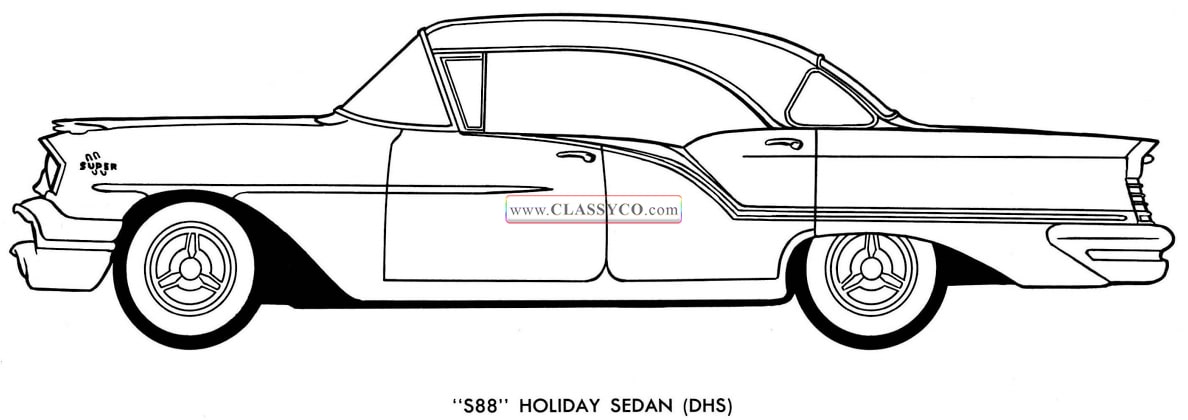
1957 Oldsmobile S88 Holiday Sedan (DHS)